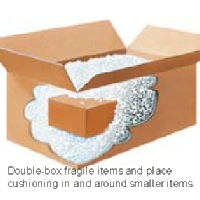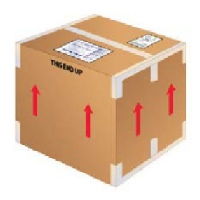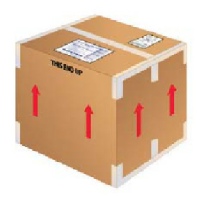

Kanafeh
From Wikipedia, the free encyclopedia
Kanafeh
Type Dessert
Kenafeh (Arabic: كنافة kanāfah), also spelled knafeh, kunafeh, or kunafah, is a traditional Arab cheese pastry soaked in sweet syrup popular in the eastern Mediterranean cuisines.
Contents [hide]
1 Preparation
2 Variants
2.1 Ka'ket Kanafeh
2.2 Kadayıf and Künefe
2.3 Kadaif
3 World records
4 See also
5 References
[edit]Preparation
Turkish kanafeh (künefe)
Kanafeh pastry comes in three types:
khishnah (Arabic خشنه) (rough) -
na'ama (Arabic ناعمة) (fine) -
mhayara (Arabic محيرة) (confused) -
The pastry is heated with butter, margarine or palm oil, then spread with soft white cheese such as Nabulsi cheese, and topped with more pastry. In khishnah kanafeh the pastry is rolled around the cheese. A thick syrup of sugar, water and a few drops of Rose water or orange blossom water is poured on the pastry during the final minutes of cooking. Often the top layer of pastry is tinted with orange food coloring. Crushed green pistachios are sprinkled on top as a garnish.
The city of Nablus is especially renowned for its kanafeh.[1]
Jerusalem kanafeh is a neon orange pastry with a crust of shredded phyllo dough or semolina filled with soft goat cheese and drenched in syrup. It is especially popular during Ramadan.
[edit]Variants
Kanafeh in a pan
Kanafeh
[edit]Ka'ket Kanafeh
This variant is popular across the Levant and Turkey, where it can be eaten for breakfast
or even for dinner as a main meal; but it is primarily considered a dessert. Eaten
as a layered treat or helwah[clarification needed], it may also be placed in a special
bread[which?] and sprinkled with sesame seeds. It is traditionally served alongside,
or drenched in, a thick, sugar-
[edit]Kadayıf and Künefe
The Turkish variant of the pastry kanafeh is called künefe, and the bunch of wirey
shreds that it is based on is called kadayıf. A semi-
[edit]Kadaif
In this variant, called also καταϊφι or κανταϊφι in Greek (kataïfi or kadaïfi), the threads are used to make pastries of various forms (tubes or nests), often with a filling of chopped nuts, like that used for baklava. A kadaif pastry is made by putting down a layer of wire kadaif, then a layer of a filling of chopped nuts, then another layer of wire kadaif. The pastries are painted with melted butter, baked until golden brown, then drenched in sugar or honey syrup.
[edit]World records
Main article: List of Palestinian records
Knafeh in Nablus 2009
The largest plate of kanafeh was made in Nablus[3] in an attempt to win a Palestinian citation in the Guinness World Records. It measured 75×2 meters and weighed 1,350 kilograms.
[edit]See also
Palestine portal
Food portal
Wikimedia Commons has media related to: Kanafeh
Phyllo
Qatayef, a dumpling-
Ekmek kadayıfı, Turkish bread custard
[edit]References
^ Cuisine Institute for Middle East Understanding.
^ http://www.politikcity.de/forum/internationale-
^ WEST BANK: Palestinian Knafeh enters Guinness World Records.
View page ratings
Rate this page
What's this?
Trustworthy
Objective
Complete
Well-
I am highly knowledgeable about this topic (optional)
Submit ratings
Categories: DessertsPastryPalestinian cuisineMiddle Eastern cuisine
Navigation menu
Create accountLog inArticleTalkReadEditView history
Main page
Contents
Featured content
Current events
Random article
Donate to Wikipedia
Wikimedia Shop
Interaction
Help
About Wikipedia
Community portal
Recent changes
Contact Wikipedia
Toolbox
Print/export
Languages
العربية
Deutsch
Español
فارسی
Français
Italiano
עברית
Kurdî
मराठी
日本語
Português
Русский
Shqip
Türkçe
中文
Edit links
This page was last modified on 25 February 2013 at 15:50.
Text is available under the Creative Commons Attribution-
Wikipedia® is a registered trademark of the Wikimedia Foundation, Inc., a non-
Contact us
Privacy policyAbout WikipediaDisclaimersMobile view
Kanafeh
From Wikipedia, the free encyclopedia
Kanafeh
Type Dessert
Kenafeh (Arabic: كنافة kanāfah), also spelled knafeh, kunafeh, or kunafah, is a traditional Arab cheese pastry soaked in sweet syrup popular in the eastern Mediterranean cuisines.
Contents [hide]
1 Preparation
2 Variants
2.1 Ka'ket Kanafeh
2.2 Kadayıf and Künefe
2.3 Kadaif
3 World records
4 See also
5 References
[edit]Preparation
Turkish kanafeh (künefe)
Kanafeh pastry comes in three types:
khishnah (Arabic خشنه) (rough) -
na'ama (Arabic ناعمة) (fine) -
mhayara (Arabic محيرة) (confused) -
The pastry is heated with butter, margarine or palm oil, then spread with soft white cheese such as Nabulsi cheese, and topped with more pastry. In khishnah kanafeh the pastry is rolled around the cheese. A thick syrup of sugar, water and a few drops of Rose water or orange blossom water is poured on the pastry during the final minutes of cooking. Often the top layer of pastry is tinted with orange food coloring. Crushed green pistachios are sprinkled on top as a garnish.
The city of Nablus is especially renowned for its kanafeh.[1]
Jerusalem kanafeh is a neon orange pastry with a crust of shredded phyllo dough or semolina filled with soft goat cheese and drenched in syrup. It is especially popular during Ramadan.
[edit]Variants
Kanafeh in a pan
Kanafeh
[edit]Ka'ket Kanafeh
This variant is popular across the Levant and Turkey, where it can be eaten for breakfast
or even for dinner as a main meal; but it is primarily considered a dessert. Eaten
as a layered treat or helwah[clarification needed], it may also be placed in a special
bread[which?] and sprinkled with sesame seeds. It is traditionally served alongside,
or drenched in, a thick, sugar-
[edit]Kadayıf and Künefe
The Turkish variant of the pastry kanafeh is called künefe, and the bunch of wirey
shreds that it is based on is called kadayıf. A semi-
[edit]Kadaif
In this variant, called also καταϊφι or κανταϊφι in Greek (kataïfi or kadaïfi), the threads are used to make pastries of various forms (tubes or nests), often with a filling of chopped nuts, like that used for baklava. A kadaif pastry is made by putting down a layer of wire kadaif, then a layer of a filling of chopped nuts, then another layer of wire kadaif. The pastries are painted with melted butter, baked until golden brown, then drenched in sugar or honey syrup.
[edit]World records
Main article: List of Palestinian records
Knafeh in Nablus 2009
The largest plate of kanafeh was made in Nablus[3] in an attempt to win a Palestinian citation in the Guinness World Records. It measured 75×2 meters and weighed 1,350 kilograms.
[edit]See also
Palestine portal
Food portal
Wikimedia Commons has media related to: Kanafeh
Phyllo
Qatayef, a dumpling-
Ekmek kadayıfı, Turkish bread custard
[edit]References
^ Cuisine Institute for Middle East Understanding.
^ http://www.politikcity.de/forum/internationale-
^ WEST BANK: Palestinian Knafeh enters Guinness World Records.
View page ratings
Rate this page
What's this?
Trustworthy
Objective
Complete
Well-
I am highly knowledgeable about this topic (optional)
Submit ratings
Categories: DessertsPastryPalestinian cuisineMiddle Eastern cuisine
Navigation menu
Create accountLog inArticleTalkReadEditView history
Main page
Contents
Featured content
Current events
Random article
Donate to Wikipedia
Wikimedia Shop
Interaction
Help
About Wikipedia
Community portal
Recent changes
Contact Wikipedia
Toolbox
Print/export
Languages
العربية
Deutsch
Español
فارسی
Français
Italiano
עברית
Kurdî
मराठी
日本語
Português
Русский
Shqip
Türkçe
中文
Edit links
This page was last modified on 25 February 2013 at 15:50.
Text is available under the Creative Commons Attribution-
Wikipedia® is a registered trademark of the Wikimedia Foundation, Inc., a non-
Contact us
Privacy policyAbout WikipediaDisclaimersMobile view


We can pack it for you?
Short on time and don’t have the supplies needed to pack your shipment? Let us pack
it for you. Our experienced staff can take care of your packing needs, whether you’re shipping
documents or fragile items. We offer a variety of shipping services and packing services,
boxes, and cushioning material to protect items in transit. If your shipment won’t
fit in a standard box, we can customize a box on-
Purchase Packaging Materials and Do It Yourself
You’ll find a variety of shipping supplies available for
purchase at our location, including:
• An assortment of corrugated boxes.
• Packaging for specialty items such as laptop computers, small electronic devices and framed art.
• Air-
Proper Packing Methods
Packaging

• Use sturdy, undamaged boxes with all flaps intact. Use double-
• Place small packages inside an outer container.
• Put 3 inches of cushioning, such as bubble padding, loosefill peanuts, corrugated
fiberboard, foam pads or molded plastic, on all sides of the container.
• Double-
• Position bottles that contain liquids upright. Use an inner seal and perforated breakaway cap. The inner packaging must be able to contain leaks.
Sealing

• Use tape that’s at least 2 inches wide to seal seams and flaps.
• Use pressure-
• Ship items that have an easily damaged or soiled finish, or items wrapped in paper,in a protective outer container.
• Two identical-
Addressing and Labeling

• Place delivery information inside and outside the package. Include an address for yourself and the recipient.
• Place shipping labels on the package’s largest surface. While we cannot ensure compliance with markings such as “Up” arrows or “This End Up,” properly placing the shipping label increases your chance for the preferred orientation. Do not place labels over seams or sealing tape.
• Use tie-
